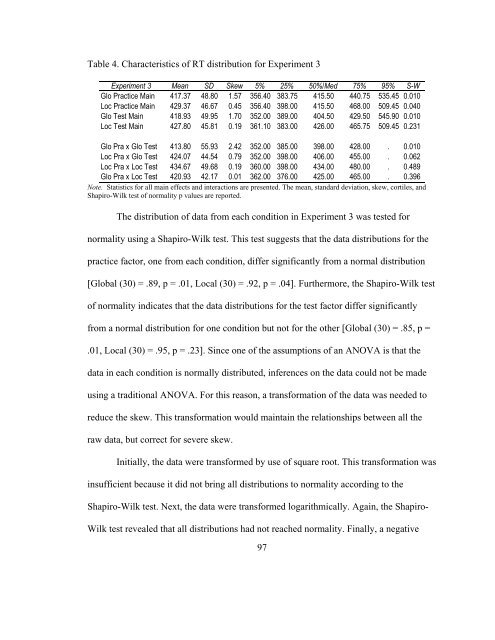The Use of Iambic Pentameter in the
The Use of Iambic Pentameter in the
The Use of Iambic Pentameter in the
Create successful ePaper yourself
Turn your PDF publications into a flip-book with our unique Google optimized e-Paper software.
Table 4. Characteristics <strong>of</strong> RT distribution for Experiment 3<br />
Experiment 3 Mean SD Skew 5% 25% 50%/Med 75% 95% S-W<br />
Glo Practice Ma<strong>in</strong> 417.37 48.80 1.57 356.40 383.75 415.50 440.75 535.45 0.010<br />
Loc Practice Ma<strong>in</strong> 429.37 46.67 0.45 356.40 398.00 415.50 468.00 509.45 0.040<br />
Glo Test Ma<strong>in</strong> 418.93 49.95 1.70 352.00 389.00 404.50 429.50 545.90 0.010<br />
Loc Test Ma<strong>in</strong> 427.80 45.81 0.19 361.10 383.00 426.00 465.75 509.45 0.231<br />
Glo Pra x Glo Test 413.80 55.93 2.42 352.00 385.00 398.00 428.00 . 0.010<br />
Loc Pra x Glo Test 424.07 44.54 0.79 352.00 398.00 406.00 455.00 . 0.062<br />
Loc Pra x Loc Test 434.67 49.68 0.19 360.00 398.00 434.00 480.00 . 0.489<br />
Glo Pra x Loc Test 420.93 42.17 0.01 362.00 376.00 425.00 465.00 . 0.396<br />
Note. Statistics for all ma<strong>in</strong> effects and <strong>in</strong>teractions are presented. <strong>The</strong> mean, standard deviation, skew, cortiles, and<br />
Shapiro-Wilk test <strong>of</strong> normality p values are reported.<br />
<strong>The</strong> distribution <strong>of</strong> data from each condition <strong>in</strong> Experiment 3 was tested for<br />
normality us<strong>in</strong>g a Shapiro-Wilk test. This test suggests that <strong>the</strong> data distributions for <strong>the</strong><br />
practice factor, one from each condition, differ significantly from a normal distribution<br />
[Global (30) = .89, p = .01, Local (30) = .92, p = .04]. Fur<strong>the</strong>rmore, <strong>the</strong> Shapiro-Wilk test<br />
<strong>of</strong> normality <strong>in</strong>dicates that <strong>the</strong> data distributions for <strong>the</strong> test factor differ significantly<br />
from a normal distribution for one condition but not for <strong>the</strong> o<strong>the</strong>r [Global (30) = .85, p =<br />
.01, Local (30) = .95, p = .23]. S<strong>in</strong>ce one <strong>of</strong> <strong>the</strong> assumptions <strong>of</strong> an ANOVA is that <strong>the</strong><br />
data <strong>in</strong> each condition is normally distributed, <strong>in</strong>ferences on <strong>the</strong> data could not be made<br />
us<strong>in</strong>g a traditional ANOVA. For this reason, a transformation <strong>of</strong> <strong>the</strong> data was needed to<br />
reduce <strong>the</strong> skew. This transformation would ma<strong>in</strong>ta<strong>in</strong> <strong>the</strong> relationships between all <strong>the</strong><br />
raw data, but correct for severe skew.<br />
Initially, <strong>the</strong> data were transformed by use <strong>of</strong> square root. This transformation was<br />
<strong>in</strong>sufficient because it did not br<strong>in</strong>g all distributions to normality accord<strong>in</strong>g to <strong>the</strong><br />
Shapiro-Wilk test. Next, <strong>the</strong> data were transformed logarithmically. Aga<strong>in</strong>, <strong>the</strong> Shapiro-<br />
Wilk test revealed that all distributions had not reached normality. F<strong>in</strong>ally, a negative<br />
97

















